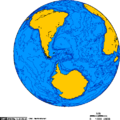South Georgia: Difference between revisions
imported>John Stephenson (title: territory) |
mNo edit summary |
||
| (2 intermediate revisions by 2 users not shown) | |||
| Line 1: | Line 1: | ||
{{subpages}} | {{subpages}} | ||
{{dambigbox|South Georgia|Georgia}} | |||
{{Image|Thatcher-Peninsula, South Georgia.jpg|right|350px| Satellite image of central South Georgia Island: Cumberland Bay; Thatcher Peninsula with King Edward Cove (Grytviken); Allardyce Range with the summit Mt. Paget.}} | |||
'''South Georgia''' is a large (3,756 square kilometres) mountainous Island in the far [[South Atlantic]].<ref name=NasaThatcher> | '''South Georgia''' is a large (3,756 square kilometres) mountainous Island in the far [[South Atlantic]].<ref name=NasaThatcher> | ||
| Line 31: | Line 32: | ||
==References== | ==References== | ||
<references/> | <references/>[[Category:Suggestion Bot Tag]] | ||
Latest revision as of 11:01, 20 October 2024
South Georgia is a large (3,756 square kilometres) mountainous Island in the far South Atlantic.[1] It is part of a British Overseas Territory with the Sandwich Islands.
The mountains valleys carry many glaciers. The coast is pierced by many fjords. Early in the 20th Century approximately a dozen of the fjords contained settlements that serviced fleets of whaling vessels. Most of the old whaling ports have been entirely abandoned. Grytviken is largely abandoned. But some buildings are kept in repair for visiting scientists and tourists.
The first explorer to land on South Georgia, and start to map its coast was James Cook.[1]
Polar explorer Ernest Shackleton is buried in Grytviken.[1]
South Georgia is a British Overseas Territory, administered from the Falkland Islands.
South Georgia was occupied by a token element of Argentinian ground forces, and scrap metal merchants, during the Falklands War.
References
- ↑ 1.0 1.1 1.2 Astronaut Photography of Earth - Display Record: ISS011-E-12148, NASA, August 26 2005. Retrieved on 2008-04-25.



